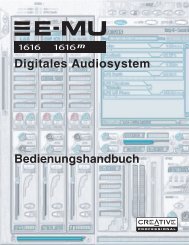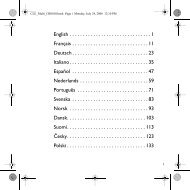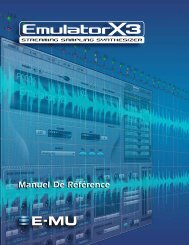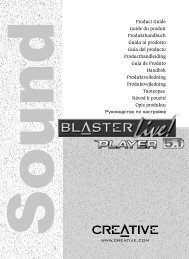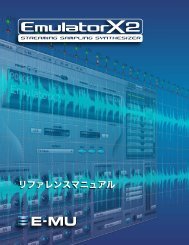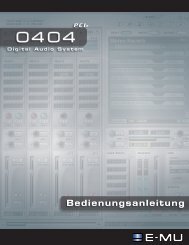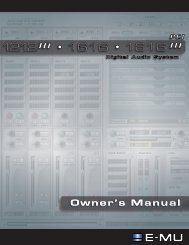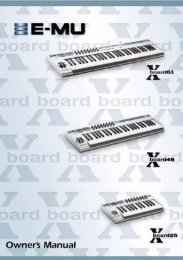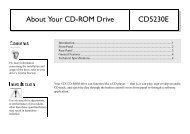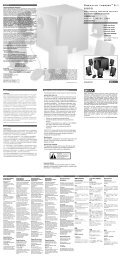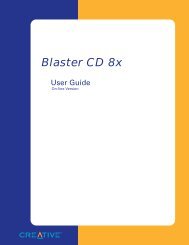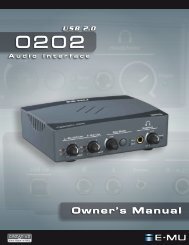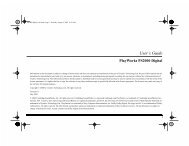You also want an ePaper? Increase the reach of your titles
YUMPU automatically turns print PDFs into web optimized ePapers that Google loves.
6 - Working with ASIO<br />
ASIO<br />
ASIO stands for Audio Stream In/Out and is a standard communication protocol<br />
between audio software and a piece of audio hardware. The low latency made possible<br />
by ASIO, for example, allows you to sing into a microphone and hear your voice going<br />
through software and hardware effects with virtually no delay in the signal. The effects<br />
of a low-latency ASIO driver make it ideal for use with Virtual Studio Technology (VST)<br />
instruments, plug-ins, and all other software-based synthesizers.<br />
IMPORTANT -> Activating ASIO<br />
It is important to understand that ASIO inputs do not appear in Cubasis or other host<br />
applications until they are CREATED in PatchMix DSP. This allows you to dynamically<br />
assign the 32 available ASIO channels according to your specific needs.<br />
For Example:<br />
1. Create a new strip from a physical source such as PCI Card S/PDIF L/R.<br />
2. Next, right-click on the new strip’s insert chain and select the Insert Send option.<br />
3. Choose an available host ASIO input.<br />
4. This S/PDIF L/R input should now be available to record in your ASIO application.<br />
ASIO Channels are STEREO!<br />
ASIO channels are stereo, period. Even when you are recording a mono source such as a<br />
microphone, the ASIO stream is stereo (with the mono signal on both channels). To<br />
record a mono input, you simply set up the Cubasis track as a mono track and use either<br />
the left or right ASIO channel from PatchMix as the input for the track.<br />
To Set Up a Stereo Recording Session:<br />
It’s best to combine the PCI Card Left and Right inputs into an ASIO pair using one of<br />
the Aux buses. Because the panning network comes BEFORE the Aux Sends you can pan<br />
the two signals left and right then combine them into a ASIO stereo pair using the Aux 1<br />
summing bus. We have provided a special PatchMix DSP Session Template for this<br />
purpose entitled, 44.1 Mono-Stereo Session. You can simply open this Template and<br />
use it for either mono or stereo recordings. Here’s how it works for Stereo:<br />
1. Create Pre-Fader PatchMix strips for the PCI Card In L and PCI Card In R.<br />
2. Create a Host ASIO Output Source PatchMix strip. (ASIO OUT 31/32 is used in the<br />
factory template.) This channel will used to monitor the output from Cubasis<br />
3. Pan PCI Card In L full Left and PCI Card In R full Right.<br />
4. Set the Aux Send 1 Amount to 0.0 on PCI Card In L and R channel strips.<br />
5. Set the Aux 1 Bus Send Amount to 0.0 in the Aux 1 Bus. (Sending to ASIO 5/6 HOST<br />
for example.)<br />
6. Place an Insert Send (Output to ASIO) into the Aux 1 Bus.<br />
7. Set the Aux 1 Bus Return Amount to -132.0 in the Aux 1 Bus. (So it won’t feed the<br />
main bus.)<br />
8. Mute the Faders on the two strips because you will monitor through Cubasis.<br />
6 - Working with ASIO<br />
ASIO<br />
f If the Insert Send<br />
comes after an effect, the<br />
effect will be recorded.<br />
See Recording &<br />
Monitoring with Effects.<br />
E-MU Digital Audio System 53



